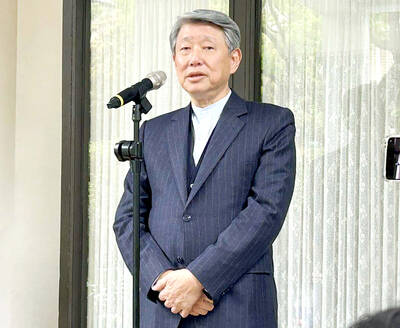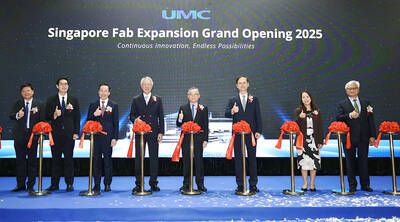The government yesterday cut feed-in tariffs for renewable energy installations by less than initially planned to speed up the nation’s “green” energy goals.
The feed-in tariff would be reduced to NT$5.8744 per unit for rooftop solar panel systems during the first half of next year, about 9 percent higher than the tariff of NT$5.3848 per unit proposed in September, the Ministry of Economic Affairs said in a statement.
The government “decided to raise feed-in tariffs for rooftop solar panel systems with a capacity below 20 megawatts to accelerate renewable energy installations,” it said.
The tariff for this type of rooftop solar panel system would drop to NT$5.7493 in the second half of next year, the ministry’s statistics showed.
This type of rooftop system is the most popular among installation applicants, the ministry said.
The new tariff for the second half of next year would represent a less drastic decline of 5.8 percent annually from NT$6.1033 for the second half of this year. If the tariff was based on the September proposal of NT$5.3848, the decline would have been 13.45 percent annually.
The feed-in tariffs for rooftop solar panel systems with different capacities, ground-mount solar panel systems and floating solar power systems would fall by between 3.79 and 5.8 percent year-on-year to between NT$4.2429 and NT$4.6901 per unit, the ministry said.
Those participating in the government’s “green” rooftop program, would get NT$6.4 per unit in feed-in tariffs if they adopt solar panels with a high conversion efficiency, the ministry said.
The feed-in tariff for offshore wind turbine installations would reach NT$5.8498 per unit over a 20 year period, 0.61 percent higher than the NT$5.8141 proposed three months ago, because of higher installation costs and extra subsidies for fishermen affected by the wind farms, the ministry said.
The new tariff means a decline of about 3.21 percent from last year’s NT$6.0437 per unit, it said.
To accelerate geothermal energy system installations, the ministry has increased the feed-in tariff to NT$6.1710 from the proposed NT$5.6447 for the first 10 years of the installations’ subsidiary period, it said, adding that the new tariff aims to help operators reduce their initial risk.
The tariff would drop to NT$3.5685 per unit for the remaining 10 years of the 20 year subsidiary period, lower than the NT$4.4465 per unit previously proposed, it said.
Meanwhile, the NT$8.3 billion “green” bonds issued by state-run Taiwan Power Co (Taipower, 台電) were listed on the nation’s over-the-counter bourse yesterday, marking the largest “green” debt issue by a local firm this year, Taipei Exchange (TPEX) said.
The debt, consisting of NT$5.6 billion seven-year bonds and NT$2.7 billion 10-year bonds, is to fund the nation’s renewable energy projects that focus on developing wind and solar power, Taipower said.
“Green” bonds traded on TPEX have reached more than NT$20 billion so far this year and the scale is expected to grow further next year, TPEX chairman Philip Chen (陳永誠) said.
Additional reporting by Kuo Chia-erh

MULTIFACETED: A task force has analyzed possible scenarios and created responses to assist domestic industries in dealing with US tariffs, the economics minister said The Executive Yuan is tomorrow to announce countermeasures to US President Donald Trump’s planned reciprocal tariffs, although the details of the plan would not be made public until Monday next week, Minister of Economic Affairs J.W. Kuo (郭智輝) said yesterday. The Cabinet established an economic and trade task force in November last year to deal with US trade and tariff related issues, Kuo told reporters outside the legislature in Taipei. The task force has been analyzing and evaluating all kinds of scenarios to identify suitable responses and determine how best to assist domestic industries in managing the effects of Trump’s tariffs, he

TIGHT-LIPPED: UMC said it had no merger plans at the moment, after Nikkei Asia reported that the firm and GlobalFoundries were considering restarting merger talks United Microelectronics Corp (UMC, 聯電), the world’s No. 4 contract chipmaker, yesterday launched a new US$5 billion 12-inch chip factory in Singapore as part of its latest effort to diversify its manufacturing footprint amid growing geopolitical risks. The new factory, adjacent to UMC’s existing Singapore fab in the Pasir Res Wafer Fab Park, is scheduled to enter volume production next year, utilizing mature 22-nanometer and 28-nanometer process technologies, UMC said in a statement. The company plans to invest US$5 billion during the first phase of the new fab, which would have an installed capacity of 30,000 12-inch wafers per month, it said. The

Taiwan’s official purchasing managers’ index (PMI) last month rose 0.2 percentage points to 54.2, in a second consecutive month of expansion, thanks to front-loading demand intended to avoid potential US tariff hikes, the Chung-Hua Institution for Economic Research (CIER, 中華經濟研究院) said yesterday. While short-term demand appeared robust, uncertainties rose due to US President Donald Trump’s unpredictable trade policy, CIER president Lien Hsien-ming (連賢明) told a news conference in Taipei. Taiwan’s economy this year would be characterized by high-level fluctuations and the volatility would be wilder than most expect, Lien said Demand for electronics, particularly semiconductors, continues to benefit from US technology giants’ effort

‘SWASTICAR’: Tesla CEO Elon Musk’s close association with Donald Trump has prompted opponents to brand him a ‘Nazi’ and resulted in a dramatic drop in sales Demonstrators descended on Tesla Inc dealerships across the US, and in Europe and Canada on Saturday to protest company chief Elon Musk, who has amassed extraordinary power as a top adviser to US President Donald Trump. Waving signs with messages such as “Musk is stealing our money” and “Reclaim our country,” the protests largely took place peacefully following fiery episodes of vandalism on Tesla vehicles, dealerships and other facilities in recent weeks that US officials have denounced as terrorism. Hundreds rallied on Saturday outside the Tesla dealership in Manhattan. Some blasted Musk, the world’s richest man, while others demanded the shuttering of his